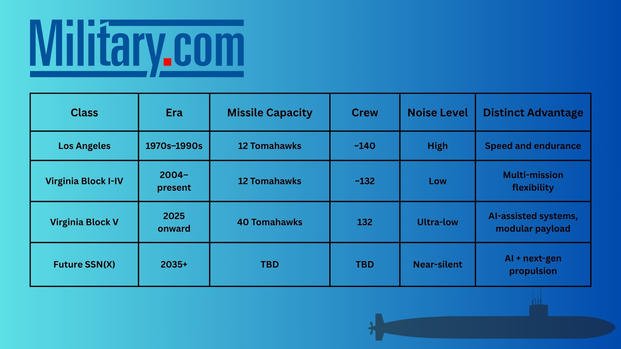Smarter, Quieter, and More Lethal Beneath the Waves
The U.S. Navy’s newest stealth submarine isn’t just quieter, it’s smarter. The USS Massachusetts (SSN-798), part of the Virginia-class Block V line, completed trials this year and represents a major leap in how the Navy fights and sustains missions beneath the surface.
These new submarines integrate AI-assisted systems and modular payload bays, allowing faster adaptation to evolving threats. Together, they mark what one senior Navy leader called a “silent revolution” in undersea warfare.
“The key for the Virginia-class Block V is that it will replace the SSGNs,” Retired Rear Adm. Jason Heinrich said in an interview with Military.com. “When they do, they’ll be very relevant players in the Pacific. The Pacific is a submariner’s playground, deep, maneuverable, and full of opportunity for training in real-world environments.”
Modular Power: One Hull, Many Missions
The Navy designed the Block V boats with the Virginia Payload Module, an extended midsection that adds four large payload tubes capable of launching up to 40 Tomahawk cruise missiles. That’s fewer than the converted Ohio-class guided-missile subs, but with far greater flexibility.
Each module can be reconfigured for different mission sets, from strike warfare to deploying SEAL teams and unmanned undersea vehicles.
“The key for modularity is the ability to provide different kinds of munitions for the mission,” Heinrich said. “That flexibility, including the option to carry SEAL teams, gives leadership real agility.”
This modular approach allows the Navy to keep submarines relevant for decades by upgrading systems within the same hull, not replacing the entire vessel. It also helps control costs and enables faster integration of new technologies like hypersonic-capable weapons expected later this decade.
AI at Depth: From Maintenance to Mission Control
Artificial intelligence is now playing a critical role in how the Navy operates, sustains, and trains its undersea fleet. For Heinrich, AI isn’t about replacing sailors; it’s about strengthening decisions.
“When you think of AI in the Navy, I look at it from two angles: warfighting and sustainment,” Heinrich told Military.com. “AI helps predict parts failures, optimize supply chains, and merge data from maintenance, weather, and operations, giving us better answers, faster.”
The Office of Naval Research is testing AI systems that assist sonar operators, monitor mechanical health, and improve mission planning. By merging massive datasets from seawater temperature to component wear, these systems can predict maintenance issues before failure occurs, saving millions in dry-dock costs.
Heinrich calls this evolution “decision intelligence,” noting that the best AI tools don’t replace human judgment; they sharpen it.
“A good AI tool doesn’t replace humans; it gives you an answer you can understand and act on,” he said.
Rebuilding the Industrial Backbone
Even as submarines grow smarter, the industrial base supporting them is shrinking. Heinrich told Military.com that over the past 15 years, the U.S. submarine industrial base has contracted by nearly half, a trend echoed in Government Accountability Office reports.
“We have to redevelop an industrial base, that’s going to be really important for us,” he said. “It’s become very difficult to start a new machine shop, and many companies that once made parts for subs are gone.”
That shortage affects both production speed and fleet sustainment. Shipbuilders General Dynamics, Electric Boat and Huntington Ingalls Industries are expanding capacity, but supply-chain gaps persist.
One emerging solution: AI-assisted additive manufacturing, essentially 3D-printing critical components.
“When there’s no manufacturer, your only alternative may be to print it,” Heinrich explained. “AI can quickly identify what parts can be produced through additive manufacturing. It helps sustain older submarines when the original suppliers are gone.”
How the Navy’s Submarine Tech Has Evolved

Why It Matters: The Future of Stealth Is Intelligent
AI and modular design promise a Navy fleet that can adapt faster than potential adversaries — extending readiness and enhancing deterrence in the Indo-Pacific.
Future programs like SSN(X) aim to merge the speed of a Seawolf, the quiet of a Virginia, and the endurance of a Columbia-class ballistic sub. The result: a fleet that’s harder to find, faster to deploy, and easier to sustain.
As Heinrich told Military.com, the next chapter of undersea warfare won’t just depend on how quietly submarines move but on how intelligently they think.
Sources
- U.S. Navy Fact File – Virginia-Class Attack Submarine (navy.mil)
- Congressional Research Service, RL32418: Navy Virginia-Class Submarine Procurement
- Office of Naval Research, AI & Autonomy Department (Code 33)
- GAO-23-106507, Defense Industrial Base: Navy Shipbuilding Workforce Challenges
- Naval Sea Systems Command, Advanced Manufacturing & Additive Sustainment
- Interview with Rear Adm. Jason Heinrich, October 18, 2025
















